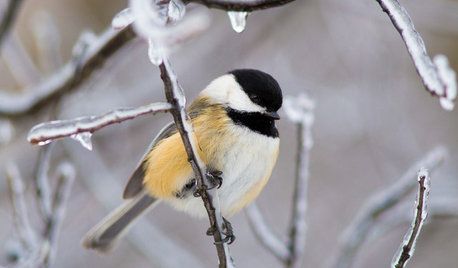The Insect Population Boom in 2010
I'll apologize in advance for the length of this post and understand if you want to skip reading it all. The bug population explosion I'm seeing here is quite amazing and I want to describe it in great detail in case it is moving north. Our weather has been hotter than average and drier than average since mid-May and those of you who have had more rain and cooler temps may not be seeing anything like I'm seeing, and may not see something similar at all this year.
I'll start off by saying that I watch my insect population very closely and try to manage it properly using a variety of organic techniques. In most years, the population of beneficial insects, which I often refer to as good bugs, keeps the population of pest bugs, which I often refer to as bad bugs, under control and I just don't really pay a lot of attention to insects. Well, I pay attention to them in terms of knowing they are there, but I just wait for the good bugs to take care of the bad bugs and I rarely intervene. I think that if you have a healthy ecosystem on your property or in your garden, the process works that way most of the time...the good bugs keep the bad bugs in check, or at least they help keep the bad bugs in check and then the rest is up to the gardener.
And THEN, along comes a year like this year....
Here in southern OK, we have seen a tremendous increase in the population of bad bugs during the last 4-6 weeks. In some cases, and I'll give an example in a minute, the population of a specific bad bug has seemingly gone from very minimal levels to huge levels overnight and I do use the term 'overnight' literally...very few of one kind of bug one day, and then hundreds of them in the garden the very next day. That kind of sudden population jump can be hard on a gardener's nerves. In those cases, your beneficial insects may not be able to keep up with the huge jump in the population of bad bugs in a timely manner and you may have to intervene more than usual to prevent severe plant damage. Even if you do not intervene, your good bug population will increase somewhat more slowly, but you'll likely have enough good bugs to control the bad bugs in several weeks. However, if severe damage is being done right now, you sometimes cannot afford to wait several weeks.
My best example for this week is the Colorado Potato Beetle. Some years I have a small number of them and I hand-pick those first few within 3 or 4 days of first noticing them and never see another one. Some years I have to handpick every day for a week or two and see maybe a couple of dozen a day. This year, I saw 5 CPB bugs one day and made a mental note to hand-pick them the next morning. Then, the next morning I got busy and didn't do that. Late that afternoon I looked at the potatoes and had hundreds and hundreds and hundreds of CPBs. I felt like they'd parachuted in from elsewhere like some sort of invading army. It simply seems incomprehensible the numbers could jump that much in one day.
I filled a plastic bowl with water, added a squirt of dishwashing liquid, and started handpicking the bugs, either picking them off the plants by hand and dropping them into the bowl to drown or by holding the bowl under the plant and knocking the bugs into the water. After I was done (and it took a LONG time), I had hundreds of CPBs...I stopped counting them at around 400 and just estimated that I had removed about 600 that day and removed every Colorado potato beetle I found on every plant, on the ground, and on the alfalfa hay mulch. Some plants had minor damage, some had major. Three or four hours later, I went back and hand-picked about 75 more until, once again, I had removed every one of them that I found. The next day, I hand-picked all over again in the early morning hours and removed 300 or 400 more, once again removing every single one I found...and I looked long and hard, checking the undersides of leaves for bugs and for eggs, which I also removed. That afternoon, I removed about 50 more. The following morning I removed about 30 more. Today I have found 8 or 10 more. All of these are in the 'new' potato bed about 40' from where I normally grow potatoes, so if they overwintered in the old area, they had to travel a bit to find the new bed. I haven't seen a single CPB in the stock tank potato bed in our granddaughter's garden which is over 100' from my garden, so apparently they haven't found it yet.
I have had some previous years when I thought Colorado Potato Beetle population levels were high, and those years were nothing, nothing, nothing at all compared to this year. That's one example but there's a few others I'll mention in a minute.
I was reading the Dallas Morning News yesterday, and I know I have mentioned on here quite often that my weather here in southern OK is more like Dallas' weather than OKC's, which makes sense as I'm only about 80 miles from Dallas and about 120 miles from OKC. In the Dallas paper there was an article about the insect population boom in North Central Texas and I found it interesting that they mentioned a specific incident where an organic farm was hit very suddenly by a large population of potato bugs just as I was here this week. I felt a little relieved to learn it was happening elsewhere, because prior to that, I thought maybe our CPB population explosion was perhaps an isolated occurrence. We have lots of clay soil here, so not many home gardeners that I know even plant potatoes.
Other insects that seem to be exploding in population here include:
GRASSHOPPERS: Since we live in a very rural area and are surrounded by literally thousands of acres of grassland which is mostly used for cattle grazing or for hay crops, we always have grasshoppers. Some years we have a fairly small number and they are perhaps annoying, but not doing a lot of damage to ornamentals, fruits or veggies. Other years, we have a moderate number and you do see high levels of damage and have to do what you can to manage the population. Every now and then we have a really bad year and they eat everything green they can find, and when they run out of green stuff, they eat tree bark, clothing or rugs, or even fiberglass window screens. I do not yet know what kind of year we'll have in 2010 because our grasshopper hatch is very late here.
Some years, I see tiny hoppers hatching out in January or February and I have to watch carefully to see if they are dying of cold exposure or something else, or if they are growing rapidly and reproducing. An early hatch in Jan. or Feb. does not necessarily mean we'll have a bad year, but it does mean to watch carefully and be ready to treat subsequent hatches while the hoppers are in the smaller instars if treatment is deemed necessary.
This year there was no early hatch. I did not see small hoppers in Jan. or Feb. or even March. I started seeing a very small number in April, but not enough to be terribly concerned about. In May, the population exploded. We have tiny hoppers everywhere. I first noticed they were eating the foliage of lemon balm and catnip, and then they moved to other herbs and ornamentals and to tomatoes, potatoes and pepper plants. Now they've moved to squash, corn and green bean plants. They are everywhere, and so are one of their main predators, which I'll get to in just a minute.
So, maybe about 3 or 4 weeks ago I became concerned it would be a bad year and I ordered Semaspore from Planet Natural so I'd have it on hand when I needed it. About 2 weeks ago, I put out about a quarter-pound of it, scattering it around the veggie gardens and ornamental beds where I was seeing damage. A week later I put out another quarter-pound. This week, I put out the remaining 1/2 pound, this time not just in the beds where I was seeing damage, but in a 3-4' buffer strip adjacent to the neighboring tall pasture grasses next door. Use of a buffer strip like that oftens halts hoppers migrating in from next door because they eat the Semaspore as they move into our property from the adjacent one. I hope the Semaspore is working because I'm still seeing huge numbers of the smaller instars. However, I think what I'm seeing is repeated new hatches because I still am not seeing any of the larger instars, which indicates the Semaspore is doing its job. Semapore, Nolo Bait and similar organic products are most effective on hoppers when they're very small, and not so effective on larger ones, so early treatment is the key to success.
BLISTER BEETLES: I began seeing blister beetles a week or two after I began seeing small hoppers. That is not at all surprising because blister beetles eat grasshopper eggs. I've always ignored blister beetles as much as possible because they often are more beneficial than destructive, but sometimes their population within the veggie garden becomes so large that I have to kill them or they completely defoliate my tomato plants. So far, I haven't harmed any of the blister beetles in my garden because they aren't harming the plants. I hope they stay busy eating grasshopper eggs and leave my tomato plants alone.
STINK BUGS: These have been in our garden since May and that's much earlier than usual. They're hard to combat and I hate them. I have both the green ones and the brown ones. I knock them to the ground and quickly step on them and squish them with my shoe when I get the chance to do so. For some reason, they seem really stupid and often fly right to me and land on my arm or my hat or my shirt, and I knock them to the ground and squish them. Apparently their internal GPS does not tell them to steer clear of humans. They can be very damaging to many plants, and especially to tomato fruit where they cause cloudy spot, so I kill every one of them that I can. I am careful not to harm the somewhat similar-looking spined soldier bugs which are good predator bugs.
SPIDER MITES: Spider mites are always with us and generally their population increases slowly from about April or May and then explodes when the really hot weather arrives in July. They're here in large numbers early this year, but so far the lady bugs are doing a good job of keeping up with them. I do not generally do anything to kill them (which is very difficult at best) and just let the lady bugs do their thing. If I wasn't seeing lady bugs around right now, I'd order a couple of batches and release them here to build up the population.
FLEAS AND TICKS: If you have domestic pets in a rural area, fleas and ticks are often a problem because they migrate from wild animals into your yard and onto your animals. We always try to keep our property as flea-free and tick-free as possible, but we're definitely seeing more this year than in most other years. We're really missing the tick-eating guineas this year after they were wiped out last year by the large predators that plagued us. I checked with a couple of neighbors who have chickens and guineas to see if they are still having issues with large predators and their birds and they are (though we are not), so I'm glad I didn't buy a new batch of keats to raise this year. I think we'll try again with the guineas next year. Predator populations usually cycle up and down to a certain extent so next year should have a lower predator population than last year and this year. This is our first year, I think, with no guineas at all since we moved her, and I miss them and their grasshopper and tick-eating habits. The chickens are doing a good job in the yard around the house, but they're fenced out of the veggie gardens because they like to eat veggies a little too much.
TOMATO HORNWORMS AND OTHER MOTH LARVAE: We are not seeing huge populations of hornworms yet and not seeing much if any hornworm damage, but in the last 5-6 days, I've seen a huge increase in the number of nightflying sphinx moths, so the population explosion is likely about to begin. I am not yet seeing many of the clearwing moths, so maybe that's why I'm not yet seeing SVB damage.
CUCUMBER BEETLES: They've been around all spring, but are really reaching large population levels right now. I try to ignore them as there are so many different flowers and veggies for them to visit here that they don't tend to concentrate their efforts too much on any one thing. In a smaller garden/landscape they might be a worse problem than they are here.
Anyway, I do not know if the rest of you are seeing a huge explosion in the population of pest bugs, but we're seeing one here and it goes at least 80-100 miles south of us throughout the Dallas-Fort Worth metro area. If it hasn't happened in your part of OK yet, be aware it is occuring south of you and be prepared to move quickly if you see any specific pest show a huge increase in population quite suddenly. Because beneficial insect populations do not start to grow until sufficient bad insects are present to feed them, your good bug population sometimes is too small to adequately deal with a sudden population explosion of bad bugs. Be aware of that and be ready to intervene early to assist your good bugs in controlling the bad bugs.
It not only is going to be long, hot summer, but apparently it is going to be a pest-fillled one too, at least here at our place.
And I didn't really forget to mention aphids, but they are pretty bad too although not really in our garden. So, I'll say it this way, the folks I know here who fertilize heavily with synthetic fertilizers with a high nitrogen content are battling huge aphid infestations. Those of us who garden mostly or completely organically and who avoid high-nitrogen fertilizers have significantly smaller numbers of aphids. We all do have more aphids than usual, but the lady bugs are controlling them with no help from us, so other than avoiding high-nitrogen fertilizers in the first place, I don't have to do anything about the aphids. There again, if the aphids were here in larger numbers than the lady bugs could handle, I'd just order and release more ladybugs.
So, that's the bug report from southcentral OK and I've linked the Dallas Morning News article in case you're interested in reading about their similar difficulties with the bug boom there. The article is oriented more towards urban areas, though, than rural areas like mine.
Dawn
Here is a link that might be useful: DMN Story on the North-Central Texas Bug Boom













p_mac
Okiedawn OK Zone 7Original Author
Related Discussions
Surround experiences 2010 thread
Q
Where's all the insects this year?
Q
Project FeederWatch #2 2009/2010
Q
What's your go to insect ID website?
Q
elkwc
seedmama
soonergrandmom
greenacreslady
annainok
Okiedawn OK Zone 7Original Author
annainok
owiebrain
Okiedawn OK Zone 7Original Author
annainok
seedmama